国际贸易实务双语教程Chapter1 International Trade Terms and Customs
- 格式:ppt
- 大小:197.59 KB
- 文档页数:80
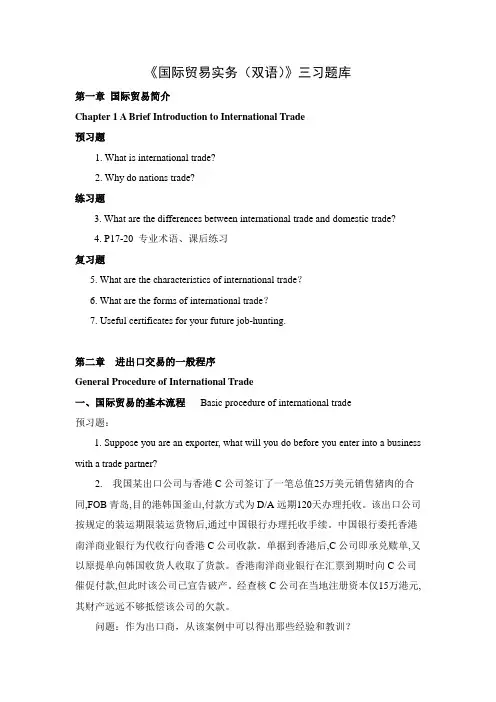
《国际贸易实务(双语)》三习题库第一章国际贸易简介Chapter 1 A Brief Introduction to International Trade预习题1. What is international trade?2. Why do nations trade?练习题3. What are the differences between international trade and domestic trade?4. P17-20 专业术语、课后练习复习题5. What are the characteristics of international trade?6. What are the forms of international trade?7. Useful certificates for your future job-hunting.第二章进出口交易的一般程序General Procedure of International Trade一、国际贸易的基本流程Basic procedure of international trade预习题:1. Suppose you are an exporter, what will you do before you enter into a business with a trade partner?2.我国某出口公司与香港C公司签订了一笔总值25万美元销售猪肉的合同,FOB青岛,目的港韩国釜山,付款方式为D/A远期120天办理托收。
该出口公司按规定的装运期限装运货物后,通过中国银行办理托收手续。
中国银行委托香港南洋商业银行为代收行向香港C公司收款。
单据到香港后,C公司即承兑赎单,又以原提单向韩国收货人收取了货款。
香港南洋商业银行在汇票到期时向C公司催促付款,但此时该公司已宣告破产。
经查核C公司在当地注册资本仅15万港元,其财产远远不够抵偿该公司的欠款。

国际贸易实务教案Chapter 1 Brief Introduction to International Trade国际贸易简介1。
1 Reasons for international trade1。
1。
1Resources Reasons(1)Natural resources.(2) Favorable climate conditions and terrain.(3)Skilled workers and capital resources。
(4) Favorable geographic location and transportation costs.1.1。
2Economic Reasons(1)Comparative advantage(2) Strong domestic demand(3) Innovation or style1。
1。
3Political Reasons1.2 Problems Concerning International Trade1。
2。
1Cultural Problems(1)Language。
(2) Customs and manners.1。
2.2Monetary Conversions1。
2.3Trade BarriersIndividual countries put controls on trade for the following three reasons:(1)To correct a balance—of-payments deficit.(2)For reasons of national security.(3)To protect their own industries against the competition of foreign goods。
Although tariffs have been lowered substantially by international agreements,countries continue to use other devices to limit imports or to increase exports. Some of these are:(1) requiring import licenses that permit only specific volumes or values imports;(2)setting quotas that limit the total value or volume of a product to be imported;(3)limiting government purchases to firms within the country;(4)applying standards for safety,consumer protection, or other reasons, which foreign products may not be able to meet;(5)making special payments called export subsidies to encourage local exporters to increase foreign sales;(6)targeting—-a new term meaning the imposition of a package of measures to give certain local industries a competitive advantage in export markets. It might include export subsidies,technical assistance,subsidies for research and development,and financial assistance;(7)requiring licenses to obtain foreign currencies by those who want to buy goods from abroad——thus limiting the quantity of imports they can buy;(8)reducing the value of a nation’s currency in relation to that of the rest of the world so that its exported goods cost less in other countries and its imports cost more;(9) imposing conditions on foreign products such as requiring that their goods contain a certain amount of locally produced products;(10)restricting trade in banking,insurance, and other service professions。
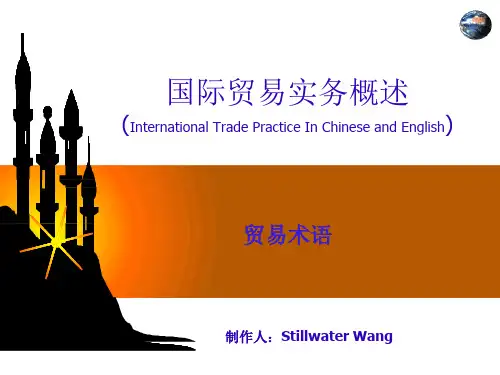

国际贸易实务双语教程第一章:国际贸易概述1.1 什么是国际贸易国际贸易是指不同国家和地区之间进行的商品和服务的交流与交易活动。
它是全球经济发展的重要组成部分,促进了各国之间的合作与发展。
1.2 国际贸易的重要性国际贸易为各国提供了更多的选择和机会,促进了资源的合理配置和优化利用。
它可以推动经济增长、创造就业机会,提高人民生活水平,并促进各国之间的和平与稳定。
1.3 国际贸易的主体国际贸易的主体包括国家、企业和个人。
国家通过制定贸易政策和法规来引导和管理国际贸易活动,企业和个人则通过进出口、外贸合作等方式参与国际贸易。
第二章:国际贸易的基本原则2.1 自由贸易原则自由贸易原则是国际贸易的基石,主张各国在贸易活动中自由、平等地开展合作,避免设置不合理的贸易壁垒和限制措施。
2.2 最惠国待遇最惠国待遇是指各国之间在关税和非关税措施方面享受相互对待的待遇。
即一国对某一国家给予的优惠待遇应当同样适用于其他所有成员国。
2.3 国民待遇原则国民待遇原则要求各国对本国产品和外国产品一视同仁,不对外国产品设置额外的贸易壁垒或歧视性规定。
第三章:国际贸易的主要方式3.1 进口和出口贸易进口贸易是指国家从其他国家购买商品和服务,出口贸易是指国家向其他国家销售商品和服务。
进出口贸易是国际贸易的主要方式。
3.2 外商直接投资外商直接投资是指一个国家的企业或个人在其他国家投资并经营企业。
它可以带来资金、技术和管理经验的引进,促进经济发展和产业升级。
3.3 跨国公司合作跨国公司合作是指不同国家的企业通过合资、合作等方式共同开展经营活动。
它可以整合各方资源,提高竞争力,实现共赢发展。
第四章:国际贸易的相关政策和机构4.1 贸易政策贸易政策是国家为了调整和管理国际贸易活动而采取的政策措施。
包括关税政策、非关税壁垒、贸易协定等。
4.2 关贸总协定(GATT)与世界贸易组织(WTO)关贸总协定是国际贸易领域的多边协议,旨在促进贸易自由化和公平竞争。
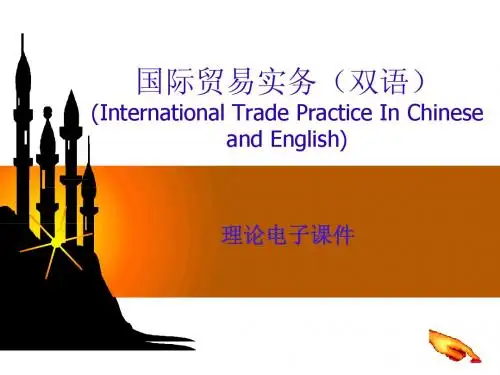

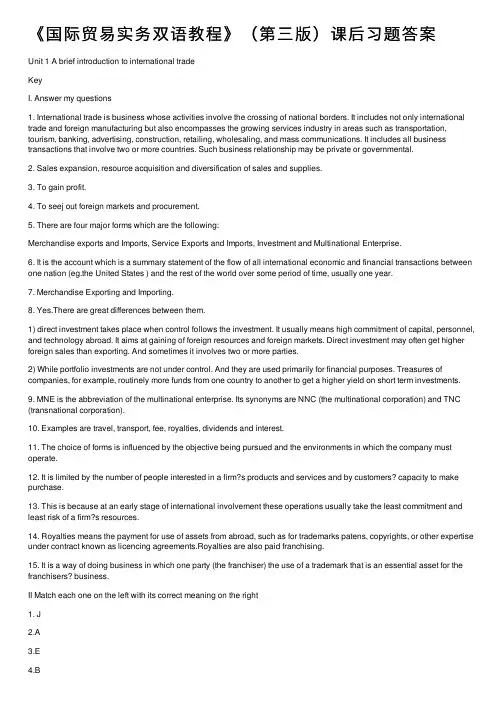
《国际贸易实务双语教程》(第三版)课后习题答案Unit 1 A brief introduction to international tradeKeyI. Answer my questions1. International trade is business whose activities involve the crossing of national borders. It includes not only international trade and foreign manufacturing but also encompasses the growing services industry in areas such as transportation, tourism, banking, advertising, construction, retailing, wholesaling, and mass communications. It includes all business transactions that involve two or more countries. Such business relationship may be private or governmental.2. Sales expansion, resource acquisition and diversification of sales and supplies.3. To gain profit.4. To seej out foreign markets and procurement.5. There are four major forms which are the following:Merchandise exports and Imports, Service Exports and Imports, Investment and Multinational Enterprise.6. It is the account which is a summary statement of the flow of all international economic and financial transactions between one nation (eg.the United States ) and the rest of the world over some period of time, usually one year.7. Merchandise Exporting and Importing.8. Yes.There are great differences between them.1) direct investment takes place when control follows the investment. It usually means high commitment of capital, personnel, and technology abroad. It aims at gaining of foreign resources and foreign markets. Direct investment may often get higher foreign sales than exporting. And sometimes it involves two or more parties.2) While portfolio investments are not under control. And they are used primarily for financial purposes. Treasures of companies, for example, routinely more funds from one country to another to get a higher yield on short term investments.9. MNE is the abbreviation of the multinational enterprise. Its synonyms are NNC (the multinational corporation) and TNC (transnational corporation).10. Examples are travel, transport, fee, royalties, dividends and interest.11. The choice of forms is influenced by the objective being pursued and the environments in which the company must operate.12. It is limited by the number of people interested in a firm?s products and services and by customers? capacity to make purchase.13. This is because at an early stage of international involvement these operations usually take the least commitment and least risk of a firm?s resources.14. Royalties means the payment for use of assets from abroad, such as for trademarks patens, copyrights, or other expertise under contract known as licencing agreements.Royalties are also paid franchising.15. It is a way of doing business in which one party (the franchiser) the use of a trademark that is an essential asset for the franchisers? business.II Match each one on the left with its correct meaning on the right1. J2.A3.E4.B5.C6.D7.I8.G9.F 10.HIII Translate the following terms and phrases into Chinese1 购买⼒11经济复苏;恢复2潜在销售量12 经济衰退3加价,涨价13间接投资4国内市场14有形货物5制成品15有形进出⼝6边际利润16收⼊及⽀出;岁⼊及岁出7市场占有率17超额能⼒8贸易歧视18贸易中间⼈(商);经纪⼈9时机选择19全部包建的⼯程承包⽅式10经销周期20许可证协定IV Case Study1 [Answer]:Batteries called "white elephant" exported from China were very popular in Southeast Asia,because "white elephant" was a lucky thing in Southeast Asia, but no one was interested in it in the market of Europe and the United States. The boss of the company was very strange that the quality of the battery or the price of reasons,so he asked his staff to investigate.Finally he found that is the brand "white elephant" to be blame.The brand's name translated into English was "white elephant" which meant something were no use but cumbersome in Western countries.It was really a bad translation from culture information perspective.The meaning derived from a legend.According to the legend,there was a king who hated a minister,so he gave a white elephant to the minister for punishment.The minister has to take care of the white elephant,he couldn't give it to others or kill it because it's the king gave it to him. However,the appetite of the white elephant was so great,and the minister became poorer.So it showed people in western countries would not buy the battery for the consumers have no willing to buy something useless but cumbersome.V. OpenVI.Translate the following into English1. Trade is often the …engine? of growth. How ever oversimplified this metaphor may be, it does serve to underline the importance of foreign trade in the process of growth. A healthy expansion of exports may not always be sufficient condition forrapid and sustained growth, but a strong positive association between the two is clearly undeniable. Trade expansion contributes to economic growth in many ways. Among them are the benefits of specialization; the favorable effects of international competition on domestic economic efficiency; the increased capacity to pay for the imports required in development and more generally the stimulus to investment.2. International trade is the exchange of goods and services produced in one country for goods and services produced in another country. In addition to visible trade, which involves the import and export of goods and merchandise, there is also invisible trade, which involves the exchange of services between nations. Nations such as Greece and Norway have large maritime fleets and provide transportation service. This is a kind of invisible trade. Invisible trade can be as important to some nations as the export of raw materials or commodities is to others. In both cases, the nations earn the money to buy necessities.3. There exist different ways of conducting international business. Exclusive sale means the seller gives the overseas client the exclusive right of selling a particular product in a designated area within a specified period of time. In this kind ofbusiness transaction, the product is bought by the exclusive seller and therefore he should sell the product by himself, assuming sole responsibilities for his profitand loss. Exclusive sale is different from agency where only commission is involved. And difference exists between general contract and exclusive sales because the exclusive seller enjoys exclusive right in a particular area.4. There is no country in the world that can produce all the products it needs. Thus countries join in international division of labor for effective production and reproduction. Sometimes a country can buy goods and services from abroad on a barter basis. Barter means doing business by exchanging goods of one sort for goods of another sort without using money. Barter trade itself is not enough to meat a country?s import n eeds. But as a form of international trade, it is still attractive in developing countries where foreign exchange is in short supply and inflow of foreign funds is far from sufficient to meet their obligations in external trade.Unit 2 General Procedures of Export and Import TransactionI. Answer the following questions(Omited)II. Filling the blanks with the suitable words in the text:1.meeting/satisfying;2.agent, foreign/overseas;/doc/a74fbca93069a45177232f60ddccda38376be1c2.html mission;4.own;5.setting;6.patent;7.profits;8.outlets; 9.joint, venture; 10.subsidiaryIII. J udge the following statement, mark True (T) or False(F)1F 2. T 3. F 4. F 5.F 6.F 7.T 8.F 9.F 10. TIV. Explain the meaning of the words or phrases below as requested1. Offer: An offer is a proposal made by sellers to buyers in order to enter into the contract.2. Withdrawal: It means an offer by the offerer has been withdrawnbefore it is reached to the offeree in order to prevent its entry into force.3. Enquiry: An enquiry is a request for business information, such as price lists, catalogue, samples, and details of the goods or trade terms. It can be made either by the importer or the exporter.4. Acceptance: Acceptance is a statement made by other conduct of the offerees indicating unconditional consent to an offer.5. Shipping agent: Shipping agent(船代)is a ship owner's representative whose job is to find the ships to carry.V. Compose a letter of enquiry with the following particulars:KeysMessrs. Arthur Grey & Son,19 Cheapside,London, E.C.2Dear Sirs,We have obtained your name and address from China Council for Promotion of International Trade and learned that you are one of the leading exporters of Ice Box in your district.We are now interested in 100 sets of the said article and should be pleased if you would let us know whether you can supply us with the quantity and quality we desire. Please quote us your best price on CIF Guangzhou basis. When offering, please state clearly terms of payment, time of delivery, packingconditions together with illustrated catalogue for our consideration.We are looking forward to your early reply.Yours faithfully,VI. Please make your offer according to the following particulars:KeyDear Sirs,Thank you for your letter of 5th May. We are glad to learn of the inquiries you have had from your customers for our raincoats. Our "D.D." range is particularly suitable for warm climates, and during the past years we have supplied this range to dealers in several tropical countries, from many of whom we have already had repeated orders. This range is popular not only because it is light in weight, but also because the material used has been specially treated to prevent excessive condensation on the inside surface.For the quantities you mention we are pleased to quote as follows:"D.D." Raincoats100 men's medium @ US$14.50 US$ 1,450100 men's small 14.0 1,400100 women's medium 13.2 1,320100 women's small 12.7 1,270US$ 5,440Payment: by irrevocable L/C at sightShipment: Shipment will be effected within three or four weeks after receiving the L/C.This offer is subject to our final confirmation. We feel you may be interested in our other products and enclose some pamphlets for your reference.We are awaiting your early orders.Yours sincerely, VII. Write a counter-offer according to the following particulars:Keys:Dear Sirs,We thank you for your quotation May 10 for 1,000 sets of Hair IceBox. We find your price as well as delivery date satisfactory, however, we would give our suggestions of an alternation of your payment terms.Our past purchase of other household electrical appliances from you has been paid as a rule by confirmed, irrevocable letter of credit at sight. On the basis, it has indeed cost us a great deal. From the moment to open credit till the time our buyers pay us, the tie-up of our funds lasts about four months. Under the present circumstances, this question is particular taxing owing to the tight money condition and unprecedentedly high bank interests.In view of our long business relations and our amicable cooperation prospects, we suggest that you accept either “cash against documents on arrival of goods” or “drawing on us at 60 day?s sight”.Your first priority to the consideration of the above request and an early favorable reply will be highly appreciated.Yours sincerely,VIII. Translate the followings into English1). Economic activity began with the cavemen, who was economically self-sufficient. He did his own hunting, found his own shelter, and provided for his own needs. As primitive populations grew and developed, the principle of division of labor evolved. One person was more able to perform some activity than another, and therefore each person concentrated on what he did best. While one hunted, another fished. The hunter then traded his surplus to the fisherman, and each benefited from the variety of diet.In today?s complex economic world, neither individuals nor nations are self-sufficient nations are self-sufficient. Nations have utilized different economic resources; people have developed different skills. This is the foundation of international trade and economic activities.Foreign trade, the exchange of goods between nations, takes place for many reasons. The first, as mentioned above, is that no nation has all of the commodities than it needs. Raw materials are scattered around the world. Large deposits of copper are mined in Peru and Zaire, diamonds are mined in South Africa, and petroleum is recovered in Middle East. Countries that do not have these resources within their own boundaries must buy from countries that export them.Foreign trade also occurs because a country often does not have enough of a particular item to meet its needs. Although the United States is a major producer of sugar, it consumes more than it can produce internally and thus must import sugar.Third, one nation can sell some items at a lower cost than other countries. Japan has been able to export large quantities of radios and television sets because it can produce them more efficiently than other countries. It is cheaper for the United States to buy these from Japan than to produce them domestically.Finally, foreign trade takes place because of innovation or style. Even though the United States produces more automobiles than any other country, it still imports large quantities of autos from Germany, Japan and Sweden, primarily because there isa market for them in the United States.2). The different kinds of trade nations engaged in are varied and complex, a mixture of visible and invisible trade. Most nations are more dependent on exports than on any other activity. The earnings from exports pay for the imports that they need and want. A nation?s balance of payment is a record of these complex transactions. By reflecting all of these transactions in monetary terms , a nation is able to combine the income it receives, for example, from exports, tourists expenditures, and immigrant remittances. This combined incomes is then spent on such items as manufactured goods from other countries, travel for its citizens to other countries, and the hiring of construction engineers.IX. Case Study[Answer]:A 公司与B公司的第⼀封信函可视为发盘,在该发盘中A公司对包装做出了要求。
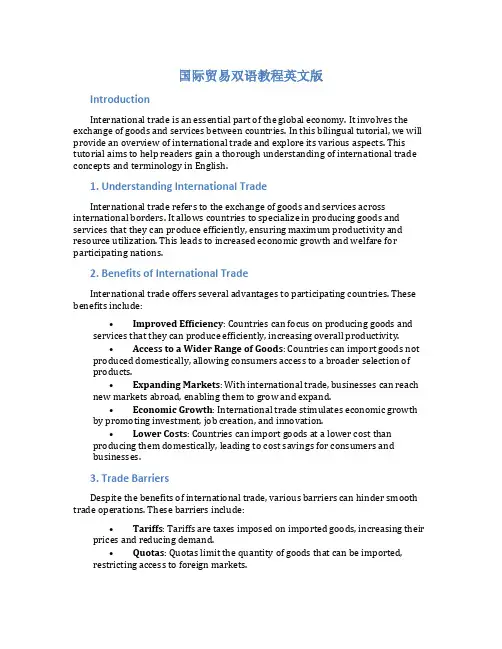
国际贸易双语教程英文版IntroductionInternational trade is an essential part of the global economy. It involves the exchange of goods and services between countries. In this bilingual tutorial, we will provide an overview of international trade and explore its various aspects. This tutorial aims to help readers gain a thorough understanding of international trade concepts and terminology in English.1. Understanding International TradeInternational trade refers to the exchange of goods and services across international borders. It allows countries to specialize in producing goods and services that they can produce efficiently, ensuring maximum productivity and resource utilization. This leads to increased economic growth and welfare for participating nations.2. Benefits of International TradeInternational trade offers several advantages to participating countries. These benefits include:•Improved Efficiency: Countries can focus on producing goods and services that they can produce efficiently, increasing overall productivity.•Access to a Wider Range of Goods: Countries can import goods not produced domestically, allowing consumers access to a broader selection of products.•Expanding Markets: With international trade, businesses can reach new markets abroad, enabling them to grow and expand.•Economic Growth: International trade stimulates economic growth by promoting investment, job creation, and innovation.•Lower Costs: Countries can import goods at a lower cost than producing them domestically, leading to cost savings for consumers andbusinesses.3. Trade BarriersDespite the benefits of international trade, various barriers can hinder smooth trade operations. These barriers include:•Tariffs: Tariffs are taxes imposed on imported goods, increasing their prices and reducing demand.•Quotas: Quotas limit the quantity of goods that can be imported, restricting access to foreign markets.•Regulatory Barriers: These include regulations, standards, and certifications that goods must meet to enter a country, creating additional costs and hurdles for exporters.•Currency Barriers: Fluctuations in exchange rates can affect the competitiveness of goods in international markets.•Trade Restrictions: Embargoes, trade sanctions, and trade wars can further hinder international trade.4. International Trade AgreementsTo promote and regulate international trade, countries often engage in the negotiation and formation of trade agreements. These agreements aim to reduce trade barriers and create a more favorable trade environment. Some prominent international trade agreements include:•World Trade Organization (WTO): The WTO is a global organization that promotes free trade and resolves trade disputes amongmember countries.•Free Trade Agreements (FTAs): FTAs are agreements between countries that eliminate or reduce trade barriers among participating nations.•Regional Trade Agreements (RTAs): RTAs are trade agreements between countries within a specific geographic region.•Bilateral Agreements: Bilateral agreements are trade agreements between two countries, focusing on addressing trade barriers and promoting trade.•Multilateral Agreements: Multilateral agreements involve multiple countries negotiating and establishing trade rules and regulations.5. Trade DocumentationInternational trade involves significant documentation to ensure smooth and legal transactions between parties. Some essential trade documents include: •Commercial Invoice: An invoice that provides detailed information about the goods being sold, including quantity, price, and delivery terms.•Bill of Lading: It is a document issued by a carrier that acknowledges the receipt of goods for shipment.•Packing List: A detailed list of the contents and quantities of a shipment.•Certificate of Origin: It certifies the origin of the goods and is needed to claim preferential treatment under trade agreements.•Insurance Certificate: A document that confirms that goods are insured against loss or damage during transportation.•Customs Declaration: A document that provides information about the goods being imported or exported and helps calculate applicable customs duties and taxes.ConclusionInternational trade plays a crucial role in the global economy, enabling countries to benefit from specialization, economic growth, and improved welfare. This bilingual tutorial aimed to provide an overview of international trade in English, covering its various aspects from understanding the basics to trade barriers, agreements, and documentation. By understanding these concepts, readers can engage in international trade activities more effectively and confidently.。
![国际贸易实务双语教程Chapter1 International Trade Terms and Customs[精]](https://uimg.taocdn.com/e674bf5db84ae45c3b358c90.webp)
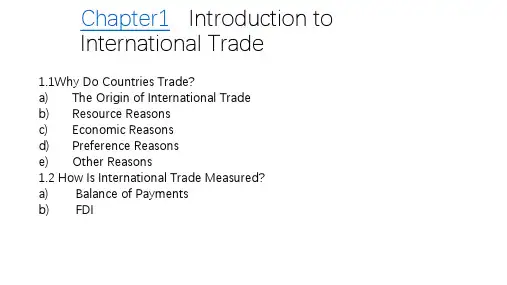

Chapter 1 International Trade1.What are the reasons for international trade?There are three main reasons: resource reasons, economic reasons, and political reasons. The resource reasons refer to the uneven distribution of resources such as natural resources, capital, and labor. The economic reasons are explained by the principal of absolute advantage and the principal of comparative advantage. Besides, nations are motivated to trade or not to trade with each other by international and domestic political needs.2.What is the principal of comparative advantage?Created by David Ricardo, the principal of comparative advantage is a basic theory for specialization and trade which says trade will benefit both nations provided only that their relative costs, that is, the ratios of their real costs measured by labor-hour or another commodity, are different for two or more commodities. In other words, trade depends on differences in comparative cost or opportunity cost, and one nation can profitably trade with another even though its real costs are higher (lower) in every commodity.3.What are the benefits of international trade?The benefits of international trade include cheaper goods, more choices of goods, wider market for domestic producers, and the growth of domestic and world economy.4. Why does trade protectionism still exist despite the benefits of international trade?Trade protectionism exists for economic and political reasons. Nations want to protect their infant industries and jobs from foreign competition, to maintain balance of payment, and not to support their foes.5.Want are some of the forms of trade restrictions?Trade restrictions take the forms of tariff barriers and non-tariff barriers.6.What is a tariff barrier and what is a non-tariff barrier?A tariff barrier is a direct monetary burden to discourage trade in which a duty or fee is levied on goods being imported into (or exported out of) a country. A non-tariff barrier, on the other hand, is not directly a monetary burden though it often costs more time and money. Non-tariff barriers include quota, license, foreign exchange control, technical standards, and regulations, etc.Terms1. A tariff: is a duty or fee that is levied on goods being imported into (or exported out of) acountry.2.Surtax: is an additional tax. It may also be temporary and discriminatory. In internationaltrade, import surtax is often collected to cope with international payment difficulties and to prevent dumping.3.Anti-dumping duty: is a fee that is collected by the importing country when it believes thatthe exporting country is selling a significant amount goods to the importing country at prices much lower than in the exporting country.4.Specific duty: is a tax of a certain sum assessed and collected on an article without referenceto its value or market.5.Ad valorem duty: is a tax which is graded according to the cost, or market value, of thearticle taxed.6. A quota: is a quantitative restriction or an upper limit in terms of physical quantity or value.7.An import license: is a permit for import issued by the government to control the import ofgoods.8.Foreign exchange control: means various forms of restriction imposed by a government onthe purchase/sale of foreign currencies by residents or on the purchase/sale of local currency by nonresidents.Chapter 2 Terms of Delivery1.What are the key issues that a contract must spell out clearly?Seller’s and buyer’s responsibilities and associated costsTime and place of deliveryDocuments and expensesTitle to the goods2.Why are Incoterms created?Incoterms are created to provide a set of international rules for the interpretation of the most commonly used trade terms in foreign trade. Thus, the uncertainties of different interpretations of such terms in different countries can be avoided or at least reduced to a considerable degree.3.How are the terms structured in Incoterms?The terms are grouped in four basically different categories: E-term, F-terms, C-terms, and D-terms. E-term requires the seller to make the goods available to the buyer usually at the seller’s own premises. F-terms require the seller to deliver the goods to a carrier appointed and paid by the buyer. C-terms require the seller to contract and pay for carriage without assuming the risk of loss of or damage to the goods or additional costs due to events occurring after shipment and dispatch. D-terms require the seller to bear all costs and risks needed to bring the goods to the place of destination.4.Do you have to use Incoterms in every transaction? Why or why not?No, sellers and buyers don’t need to use Incoterms in their transaction because Incoterms are created only to provide an option, not an obligation.5.What should be considered in the choice of terms of delivery?Transport capacityCustomer’s locationFreight rateLoading/unloading facilities and local port customRisks in transitChapter 3 Cargo Packaging, Stowage & Marking1.Generally speaking, what are the main reasons for cargo packaging?Generally speaking, there are four main reasons for cargo packaging:a.protective function that essentially involves protecting the contents from the environment andvice versa;b.loading and transport function that requires proper packaging design for easy handling andspace-saving transportationc.stowage function that facilitates stowage and distribution; andd.promotion function that helps generate product awareness and sales2.The protective function of packaging essentially involves protecting the contents fromthe environment. Is this statement true or false and why?This statement is only partially true because the protective function of packaging involves protecting people and the environment, not only the contents, particularly for hazardous materials.3.What is the most efficient method of handling general cargo?The most efficient method of handling general cargo is to make up cargo unit.4.What are the main factors influencing types of cargo packaging?The main factors influencing types of cargo packaging are:a.nature of cargo;b.transport;c.Customs and statutory requirements;d.Insurance acceptance conditions;e.Cost; andf.Ease of handling and stowage5.What should be considered in the stowage of cargo?The following should be considered in the stowage of cargo:a.observation of weight limitations and distributions;b.prevention of damage to transport vehicle;c.best use of available deadweight or cubic capacity to minimize the broken stowage;d.avoidance of mixing incompatible cargo;e.plan for ease of unloading6.What purposes does correct and complete marking serve?Correct and complete marking of packages helps prevent incorrect handling, accidents, incorrect delivery, losses of weight and volume and Customs fines7.What are the main types of marks?The main types of marks include shipping marks, information marks, indicative marks and warning marks.8.What are the marking requirements?The marking requirements are internationality, visibility, legibility and indelibilityChapter 4 Transport1.What are the key differences between liners and tramps?A liner operates over a regular route according to an advertised time-table but a tramp does not operate this way. Instead, a tramp is a vessel hired to pick up cargo from almost any port and go directly to the port of destination.2.What does the abbreviation FIO stand for? What does it mean?FIO stands for “free in and out”, which means that the charterer of a vessel, not the ship operator, is responsible for the costs of loading and unloading.3.What key purposes does a B/L serve?A B/L serves three key purposes. First, it is evidence that a valid contract of carriage exists between the carrier and the shipper, and it may incorporate the full terms of the contract between them. Second, it is a receipt signed by the carrier confirming whether goods matching the contract description have been received from the shipper in good condition. Third, it is also a document of title, creating ownership of the goods shipped.4.What should a clause of shipment include?A clause of shipment should include time of shipment, port of shipment and port of destination, advice of shipment, partial shipment and transshipment.5.What is Air Waybill and what is the key difference between the document and an OceanB/L?An air waybill is a transport document issued by airlines or air cargo companies or their agents. The key difference between this document and an ocean B/L is that air waybill is not a title document. As a straight waybill, an air waybill is not transferrable or negotiable and a shipper does not lose his ownership of the cargo by handing the air waybill to the airline. However, as the buyer is named the consignee on the waybill and he/she can claim the consignment from the carrier by simply showing proof of identity.6.What is international multimodal transport?International multimodal transport is the carriage of goods by at least two different modes of transport on the basis of a multimodal transport contract from a place in one country at which the goods are taken in charge by the multimodal transport operator to a place designated for delivery situated in a different country.7.What are the general considerations in cargo transport?Reliability, speed and frequency, and cost.Chapter 5 Foreign exchange rate & Contract formation- Offer & Acceptance1.How is the exchange rate between any two currencies expressed?There are two ways to express the exchange rate between any two currencies, i.e., the price of Currency A can be quoted in terms of Currency B or vice versa. Depending on whether home currency is used to express the price of foreign currencies or foreign countries are used to express the price of home currency, we have direct quotation and indirect quotation.2.How many rates does a bank normally quote?Two, a buying (bid) rate and a selling(ask)rate.3.Why is exchange rate an important issue for international traders?While the exchange rates between currencies float, payment is normally made sometime after the contract is concluded. The final earnings in the home currency (if the contract currency is a foreign currency) will only be known with the prevailing exchange rate at the time the payment is made. A favorable exchange rate will give the exporter more home currency. On the other hand, an adverse movement of the exchange rates will bring him a loss in terms of home currency.4.How can we manage the exchange rate risks (foreign exchange risks)?There are a number of choices: choosing the right currency for a transaction, booking a forward contract, and using other products that banks offer.5.If you intend to make your offer indefinite, what can you do to avoid misinterpretation?If an offerer wants to make an offer indefinite, he should make clear reservations to avoid misinterpretation.6.How can you terminate an offer?An offer can be terminated by:The party offering may revoke the offer if no consideration has been given.The offer may lapse (either after a specified time, or it may just become stale).Offer may come to an end after a stipulated event occurs or does not occur.Offer may lapse on death of the party offeringOffer is killed by a counter-offer.7.Who can accept an offer?Only the offeree can accept an offer.8.What does acceptance mean to a contract?Since an acceptance indicates assent to an offer, it validates the contract and means that boththe offerer and the offeree will be bound by the terms and conditions in the offer.9.What is a counter-offer?A counter-offer is either the office’s proposal of a new set of terms for the transaction or his conditional acceptance by making actual, material changes in the offer.1.Foreign exchange: is the currency of any foreign country which is the authorized instrumentof settlement and the basis for record keeping in that country.2.Like any other commodities, a foreign exchange has a price, which is expressed in anothercurrency. Exchange rate is the price relationship between the currencies of two countries or the price of one currency in terms of the other.3.Offer rate(of foreign exchange):is the price at which a bank is willing to sell foreignexchange to its customers4. A definite offer:is one that clearly expresses the offerer’s willingness in concluding atransaction by providing complete and clear information for the deal. Normally it includes all the necessary items for a transaction, specifies the time by which the offer is valid and the time the acceptance must be received, and uses the phrase “offer firm” meaning that the offer is made without reservations.5.An acceptance: is a statement made by the offeree indicating assent to an offer.。